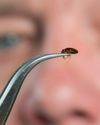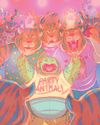
LIUZHOU, CHINA
GARDEN STATE
Can forest cities help to mop up our pollution?
Traditionally, the more people in a city, the fewer trees there are. To create space for houses, offices and other buildings, nature takes second place. But, if architect Stefano Boeri has anything to do with it, this will soon be changing.
Boeri has designed a forest city, to be created in the north of Liuzhou – a metropolis in the Guangxi region in southern China. This mountainous area was chosen to be “a city where living nature is totally intertwined with architecture”, according to Boeri. Instead of completely getting rid of the trees to build houses, the city’s design accommodates the surrounding greenery. Homes and commercial buildings will be covered with trees, with gardens on the balconies of every floor, and rooftops that are home to miniature forests. “I have been working on the idea of urban forestation for years,” says Boeri. “In those areas of the planet where it is still necessary to build new cities, we are planning real forest cities for a maximum of 150,000 inhabitants.”
The Liuzhou Forest City will be connected to central Liuzhou via a railway line and a road. It will be home to 30,000 people, and include commercial and recreational spaces, two schools and a hospital. On top of this, the vegetation will absorb carbon dioxide and pollutants, as well as releasing oxygen into the atmosphere.
This story is from the {{IssueName}} edition of {{MagazineName}}.
Start your 7-day Magzter GOLD free trial to access thousands of curated premium stories, and 9,000+ magazines and newspapers.
Already a subscriber ? Sign In
This story is from the {{IssueName}} edition of {{MagazineName}}.
Start your 7-day Magzter GOLD free trial to access thousands of curated premium stories, and 9,000+ magazines and newspapers.
Already a subscriber? Sign In

TAKE IT SLOW
Slow running is a fitness trend with some hard and fast science behind it

Physics, AI and music share a common thread. You just have to know where to look
Studying science can lead you in many directions and open doors to unexpected possibilities along the way

BED BUGS VS THE WORLD
When bloodthirsty bed bugs made headlines for infesting Paris Fashion Week in 2023, it shone a spotlight on a problem that's been making experts itch for decades: the arms race going on between bed bugs and humans

Kids are the key to understanding obesity. But we need more of their genes...
We can unravel the role that bodyweight plays in disease, but we need a bigger, more diverse, sample of genetic material to do so

COVID inquiry: What did we learn and what can we do better in future pandemics?
Masks, social distancing, lockdowns... how effective was the UK's response to the COVID-19 pandemic?

One hormone could be the key that unlocks a cure for morning sickness
The nausea and vomiting that, in extreme cases, can endanger mothers and babies might soon be just a memory

THE WORLD'S WEIRDEST CREATURES
Under the sea and upon the land, some animals look - to us - pretty strange...

WHEN MIND AND MACHINE COLLIDE
First, Elon Musk wanted to make electric cars ubiquitous, then he wanted to make space exploration a private enterprise. Now, with Neuralink, his newest venture, Musk hopes to merge humans and artificial intelligence. Turns out, it might not be such a crazy idea...

COME OUT OF YOUR SHELL
Social anxiety is more than just being shy. It's a phobia born out of our evolutionary past. But that raises a puzzling question: why do so many of us fear human interaction when we're supposed to be the most sociable species on the planet?

SPACE ODDITIES
Take a tour of the weirdest spots in the universe, where the 'normal' rules don't apply. Places that squeeze time, blow bubbles and even rain glass... sideways